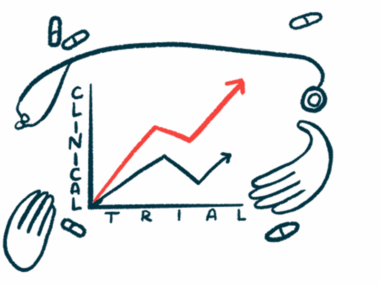Cerevance’s solengepras reduces off-time as levodopa add-on therapy
Adding therapy to standard treatment decreased off time in a Phase 2 trial
Written by |

Adding Cerevance’s investigational oral therapy solengepras (CVN424) to standard Parkinson’s disease treatment significantly decreased off time, when symptoms return or worsen, according to the data from a completed Phase 2 trial.
The trial met its main efficacy goal, with a reduction in average off time at the end of the treatment, according to a company press release.
“We are excited to share the results of this important Phase 2 study with the broader scientific community,” said Craig Thompson, Cerevance’s CEO. “The data demonstrated solengepras’ potential to be a meaningful therapeutic option for individuals with Parkinson’s disease, addressing not only motor symptoms but also overall quality of life.”
The full results were published in eClinicalMedicine in “CVN424, a GPR6 inverse agonist, for Parkinson’s disease and motor fluctuations: a double-blind, randomized, phase 2 trial.”
Parkinson’s disease is caused by the degeneration of nerve cells (neurons) that produce dopamine, a crucial neurotransmitter for regulating muscle movement. Levodopa, a dopamine precursor, has long been a primary treatment option for this condition.
As the disease progresses, however, patients may have off periods, times when symptoms reemerge despite the medication being taken. These symptoms typically include tremors and uncontrolled and involuntary movements, called dyskinesia, which can significantly affect patients’ quality of life.
Solengepras is a small oral molecule that can enter the brain and influence the function of certain nerve cells in the striatum, a region critical for controlling voluntary movement. The experimental treatment specifically blocks GPR6, a protein receptor produced by a type of neuron in the striatum that helps regulate and control movement. By suppressing GPR6, solengepras should produce beneficial effects similar to levodopa’s while minimizing the negative side effects, such as dyskinesia,
Less off time, more on time with solengepras
The Phase 2 trial (NCT04191577) enrolled 141 adults, ages 30-80, with Parkinson’s disease who’d been taking a consistent dose of levodopa and other anti-parkinsonian medications for at least 30 days before the study, and continued with the same dosage throughout the trial. By the beginning of the study they’d had at least a mean of two hours or more per day of off time, despite treatment.
The participants were randomly divided into three groups who received either a low dose (50 mg) or high dose (150 mg) of solengepras, or a placebo, once a day for 28 days. In total, 127 patients completed the treatment course.
Consistent with early data, solengepras led to a dose-dependent reduction in off-time. At 50 mg, patients saw a mean 1.3-hour reduction in off time over the placebo. At the high dose, this increased to a 1.6-hour reduction, a statistically significant difference, as assessed by patients’ reports of daily motor symptoms.
The reductions were accompanied by an increase in on time, periods when symptoms are well controlled, without troublesome dyskinesia. In the high dose group, on time increased by a mean of 0.67 hours.
A post hoc analysis of patients who had more than three hours of off time at the trial’s start further confirmed solengepras’ benefits, with the high dose group showing a statistically significant mean reduction in off time of 1.78 hours over the placebo and an increase of on time by a mean of 1.3 hours. A post hoc study is one that’s specified and performed after a trial is complete.
Patients receiving solengepras showed signs of reduced sleepiness, as indicated by a trend toward lower Epworth Sleepiness Scale (ESS) scores, where higher scores indicate more sleepiness. After 15 days of treatment, the average ESS score in the high-dose group decreased by 1.35 points over the placebo group, a significant amount.
Solengepras was generally well tolerated, with no reported serious treatment-related adverse events, the most common being headache and nausea, which were generally mild and transient.
Solengepras is also being tested as a single therapy in the Phase 2 ASCEND clinical trial (NCT06006247) and as an add-on to levodopa in the Phase 3 ASCEND (NCT06006247) study.






